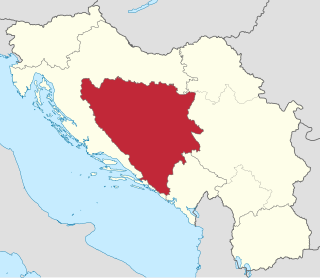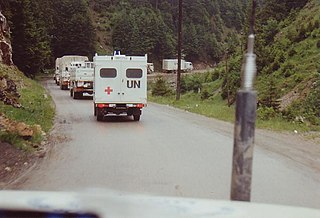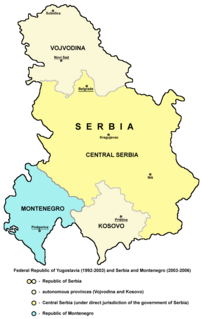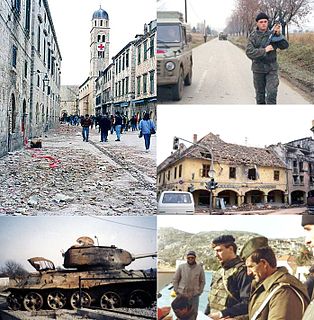 W
WParliamentary elections were held alongside the presidential elections in Croatia on 2 August 1992, the first after independence and under the new constitution. All 138 seats in the Chamber of Representatives were up for election. The result was a victory for the Croatian Democratic Union, which won an absolute majority of 85 seats. Voter turnout was 75.6%.
 W
WOperation Baranja was an aborted offensive of the Croatian Army north of the towns of Belišće and Valpovo, Croatia on 3 April 1992 during the Croatian War of Independence. The offensive quickly gained ground after the HV advanced north of the Drava River into Baranja. The defending force of the Croatian Serb Territorial Defence Force supported by the Yugoslav People's Army artillery were caught unprepared and offered light resistance.
 W
WThe Siege of Dubrovnik was a military engagement fought between the Yugoslav People's Army (JNA) and Croatian forces defending the city of Dubrovnik and its surroundings during the Croatian War of Independence. The JNA started its advance on 1 October 1991, and by late October, it had captured virtually all the land between the Pelješac and Prevlaka peninsulas on the coast of the Adriatic Sea, with the exception of Dubrovnik itself. The siege was accompanied by a Yugoslav Navy blockade. The JNA's bombardment of Dubrovnik, including that of the Old Town—a UNESCO World Heritage Site—culminated on 6 December 1991. The bombardment provoked international condemnation, and became a public relations disaster for Serbia and Montenegro, contributing to their diplomatic and economic isolation, as well as the international recognition of Croatia's independence. In May 1992, the JNA retreated to Bosnia and Herzegovina, less than 1 kilometre from the coast in some places, and handed over its equipment to the newly formed Army of Republika Srpska (VRS). During this time, the Croatian Army (HV) attacked from the west and pushed back the JNA/VRS from the areas east of Dubrovnik, both in Croatia and in Bosnia and Herzegovina, and by the end of May linked up with the HV unit defending the city. Fighting between the HV and Yugoslav troops east of Dubrovnik gradually died down.
 W
WThe 1992 European Community Monitor Mission helicopter downing was an incident that occurred on 7 January 1992, during the Croatian War of Independence, in which a European Community Monitor Mission (ECMM) helicopter carrying five European Community (EC) observers was downed by a Yugoslav Air Force Mikoyan-Gurevich MiG-21, in the air space above the village of Podrute, near Novi Marof, Croatia. An Italian and a French officer and three Italian non-commissioned officers were killed. Another ECMM helicopter flying in formation with the attacked helicopter made an emergency landing. The second helicopter carried a crew and a visiting diplomat, all of whom survived. The incident was condemned by the United Nations Security Council and the EC. As a result of the incident, the Yugoslav authorities suspended the head of the air force, and the Yugoslav defense minister, General Veljko Kadijević, resigned his post. The events followed the end of the first stage of the war in Croatia and closely preceded the country's international recognition.
 W
WThe Independence of Croatia was a process started with the changes in the political system and the constitutional changes in 1990 that transformed the Socialist Republic of Croatia into the Republic of Croatia, which in turn proclaimed the Christmas Constitution, and held the 1991 Croatian independence referendum.
 W
WThe Battle of the Miljevci Plateau was a clash of the Croatian Army and forces of the Republic of Serbian Krajina (RSK), fought on 21–23 June 1992, during the Croatian War of Independence. The battle represented the culmination of a series of skirmishes between the HV and the RSK forces in Northern Dalmatia, after the implementation of the Vance plan and deployment of the United Nations Protection Force (UNPROFOR) began. The skirmishes occurred in the pink zones—areas under control of the RSK, but outside the UN Protected Areas established by the Vance plan.
 W
WPresidential elections were held in Croatia for the first time on 2 August 1992 alongside simultaneous parliamentary elections. The result was a victory for incumbent Franjo Tuđman of the Croatian Democratic Union (HDZ), who received 57.8% of the vote, becoming the first popularly elected president of Croatia. Voter turnout was 74.9%.
 W
WUnited Nations Security Council resolution 740, adopted unanimously on 7 February 1992, after reaffirming resolutions 713 (1991), 721 (1991), 724 (1991) and 727 (1992) and considering a report by the Secretary-General Boutros Boutros-Ghali, the Council approved plans for a peacekeeping mission in the Socialist Federal Republic of Yugoslavia.
 W
WUnited Nations Security Council resolution 752, adopted unanimously on 15 May 1992, after reaffirming resolutions 713 (1991), 721 (1991), 724 (1991), 727 (1992), 740 (1992) 743 (1992) and 749 (1992), the Council expressed concern at the situation in the Yugoslavia, in particular the fighting in Bosnia and Herzegovina, demanding that all parties end the fighting and respect the ceasefire signed on 12 April 1992.
 W
WUnited Nations Security Council resolution 753, adopted without a vote on 18 May 1992, after examining the application of the Republic of Croatia for membership in the United Nations, the Council recommended to the General Assembly that Croatia be admitted. The recommendation came amid the breakup of Yugoslavia.
 W
WUnited Nations Security Council resolution 762, adopted unanimously on 30 June 1992, after reaffirming resolutions 713 (1991), 721 (1991), 724 (1991), 727 (1992), 740 (1992) 743 (1992), 749 (1992), 752 (1992), 757 (1992), 758 (1992), 760 (1992) and 761 (1992), the Council urged all parties to honour their commitments to the United Nations plan in former Yugoslavia and complete a cessation of hostilities.
 W
WUnited Nations Security Council resolution 764, adopted unanimously on 13 July 1992, after reaffirming previous resolutions on the topic, the Council noted the violations of the agreement concerning Sarajevo International Airport which established a security corridor and demanded withdrawal of anti-aircraft weapon systems, and decided to authorise an additional deployment of United Nations Protection Force personnel. It would increase the size of the Force to two infantry battalions.
 W
WUnited Nations Security Council resolution 769, adopted unanimously on 7 August 1992, after reaffirming Resolution 743 (1992) and all subsequent resolutions relating to the United Nations Protection Force (UNPROFOR), the Council authorised enlargements in the strength and mandate of UNPROFOR to "enable the Force to control the entry of civilians into the United Nations Protected Areas", in addition to performing immigration and customs functions.
 W
WUnited Nations Security Council resolution 770, adopted on 13 August 1992, after reaffirming previous resolutions on the topic, including Resolution 743 (1992), Resolution 749 (1992), Resolution 761 (1992) and Resolution 764 (1992), the Council recognised the humanitarian situation in Sarajevo and other areas in Bosnia and Herzegovina.
 W
WUnited Nations Security Council resolution 771, adopted unanimously on 13 August 1992, after reaffirming resolutions 713 (1991), 721 (1991), 724 (1991), 727 (1992), 740 (1992), 743 (1992), 749 (1992), 752 (1992), 757 (1992), 758 (1992), 760 (1992), 761 (1992), 762 (1992), 764 (1992), 769 (1992) and 770 (1992), the Council expressed concern at and condemned widespread violations of international humanitarian law in the territory of the former Yugoslavia and in particular, Bosnia and Herzegovina.
 W
WUnited Nations Security Council resolution 776, adopted on 14 September 1992, after reaffirming Resolution 743 (1992) and noting offers of assistance made by Member States since the adoption of Resolution 770 (1992), the Council authorised an increase in the size and strength of the United Nations Protection Force in Bosnia and Herzegovina and other areas of the former Yugoslavia.
 W
WUnited Nations Security Council resolution 779, adopted unanimously on 6 October 1992, after reaffirming Resolution 743 (1992) and subsequent resolutions and noting a report by the Secretary-General Boutros Boutros-Ghali submitted pursuant to resolutions 743 and 762 (1992), the Council authorised the United Nations Protection Force (UNPROFOR) to assume responsibility for monitoring the complete withdrawal of the Yugoslav People's Army from Croatia, demilitarization of the Prevlaka peninsula and the removal of heavy weapons from neighbouring areas of Croatia and Montenegro in co-operation with the European Community Monitoring Mission.
 W
WUnited Nations Security Council resolution 786, adopted unanimously on 10 November 1992, after reaffirming Resolution 781 (1992), the Council approved a recommendation by the Secretary-General Boutros Boutros-Ghali to increase the strength of the United Nations Protection Force (UNPROFOR) in Bosnia and Herzegovina by 75 observers to monitor the ban on military flights over the country.
 W
WUnited Nations Security Council resolution 787, adopted on 16 November 1992, after reaffirming Resolution 713 (1991) and all subsequent resolutions on the topic, the Council called upon the parties in Bosnia and Herzegovina to consider the draft outline constitution as a basis for negotiating a political settlement of the conflict in the country, and went on to impose further international sanctions on the Federal Republic of Yugoslavia.
 W
WUnited Nations Security Council resolution 798, adopted unanimously on 18 December 1992, after reaffirming 770 (1992) and 771 (1992) and supporting an initiative by the European Council.The Council condemned reports of the massive, organized and systematic detention and rape of women, in particular Muslim women, in Bosnia and Herzegovina during the Bosnian War.
 W
WThe 1991 Yugoslav campaign in Croatia was a series of engagements between the Yugoslav People's Army (JNA), the Yugoslav Navy and the Yugoslav Air Force, and the Croatian National Guard (ZNG) then the Croatian Army (HV) during the Croatian War of Independence. The JNA was originally deployed in order to preserve Yugoslavia, and the initial plan of the campaign entailed the military occupation of Croatia and the removal of the Croatian leadership elected in 1990. The JNA intervention was the culmination of its involvement in the confiscation of weapons from Croatia's Territorial Defence, and in the Croatian Serb revolt that had begun in August 1990. From that time, the JNA had been frequently deployed to form a buffer zone between the insurgents and the ZNG or the Croatian police. In effect, these JNA buffer zones often secured the territorial gains of the insurgents and led to an increasingly hostile relationship between the JNA and Croatia. The JNA campaign plan was amended shortly before the campaign to include the relief of JNA barracks besieged by the ZNG. The besieging and subsequent capture of several JNA facilities allowed Croatia to arm its previously poorly equipped military and to equip new recruits.